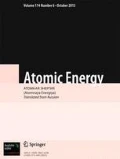Abstract
The term “thermophysics” encompasses three areas – hydrodynamics, heat transfer, and technology of coolants. These areas are closely interrelated and influence reactor physics, corrosion processes, and the reliability and safety of a nuclear power system. At the present level of knowledge, when developing prospective fourth-generation reactors and other power systems, the thermophysical processes occurring in the loops must be considered not separately but together, taking account of their mutual influence on the operation of the loops in the nuclear power system. These processes also must be taken into account in order to develop systems for controlling them.
Similar content being viewed by others
REFERENCES
Hydrodynamics and Heat Transfer in Nuclear Power Systems, Atomizdat, Moscow (1975).
I. E. Idel'chik, Handbook of Hydraulic Resistance, Mashinostroenie, Moscow (1975).
I. E. Idel'chik, Aerodynamics of Technological Apparatus, Mashinostroenie, Moscow (1983).
S. Kliem, U. Rohde, and F. Weiss, “Analysis of PWR core behavior after entrance underborated water,” Annual Meeting on Nuclear Technology, Rössendorf, Berlin (2003).
D. A. Labuntsov and V. V. Yagov, Mechanics of Two-Phase Systems, MéI, Moscow (2000).
Yu. V. Yudov, S. N. Volkova, and Yu. A. Migrov, “Closure relations for thermohydraulic model of the KORSAR computer code,” Teploénergetika, No. 11, 22–29 (2002).
A. P. Sorokin, E. F. Ivanov, V. L. Mal'kov, et al., “Experimental investigations of heat transfer and stability of the boiling of liquid metal in a natural circulation loop,” Preprint FéI-2631 (1997).
Thermohydraulic Relationships for Advanced Water Cooled Reactors,IAEA-TECDOC-1203, April 2001, Vienna.
P. L. Kirillov, “Experience in operating reactors indicates the need for new thermohydraulic studies,” At. Tekh. Rubezh., No. 9, 3–9 (2003).
P. L. Kirillov, “Transition to supercritical parameters-a way to improve nuclear power plants with water-cooled reactors,” Teploénergetika, No. 12, 6–10 (2001).
V. M. Voronov and T. I. Petrova, “Problems of organizing the water-chemistry at heat-and-power plants,” Teploénergetika, No. 7, 2–6 (2002).
V. M. Voronov, P. N. Nazarenko, and V. K. Pauli, “Some principles for adopting chemical-technological monitoring systems,” Teploénergetika, No. 6, 2-7 (1997).
V. I. Subbotin, M. N. Ivanovskii, and M. N. Arnol'd, Physical and Chemical Principles for Using Liquid-Metal Coolants, Atomizdat, Moscow (1970).
P. N. Martynov, R. Sh. Askhadullin, A. I. Simakov, et al., “Regulation of the oxygen potential of lead coolant,” in: Heat and Mass Transfer and the Properties of Liquid Metals, Obninsk (2002), Vol. 1, pp. 185–187.
Rights and permissions
About this article
Cite this article
Gulevich, A.V., Efanov, A.D., Kirillov, P.L. et al. Basic Questions Concerning the Thermophysics of Nuclear Power. Atomic Energy 96, 352–357 (2004). https://doi.org/10.1023/B:ATEN.0000038102.35927.ea
Issue Date:
DOI: https://doi.org/10.1023/B:ATEN.0000038102.35927.ea


